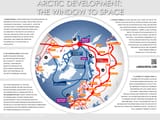The Bering Strait Connection
Posted on April 19, 2016
打印这篇文章 打印这篇文章
(Excerpt from “The United States Joins The New Silk Road: A Hamiltonian Vision for an Economic Renaissance”)
The ancient Silk Road linked two great centers of civilization—Asia and Europe—uniting the landmass of Eurasia into a single continent and opening the interior of this continent to human settlement and a cross-fertilization of culture. The New Silk Road, which is already in the process of being built, promises to far supersede the historic accomplishments of its namesake. It is integrating Eurasia through modern modes of high-speed transport and other types of development, but can also be extended on a global scale.
The New Silk Road can become the World Land-Bridge by means of the construction of a Bering Strait rail connection, uniting the two great landmasses of the planet, Eurasia and the Americas, just as the original Silk Road bridged the East and West. Imagine boarding a magnetically-levitated train in downtown Paris or Berlin, travelling at 250 mph across the steppes of Siberia, through an underwater Bering Strait tunnel across more than 50 miles of ocean, emerging on the other side in Alaska, and ultimately arriving in New York City!
Not only would the completion of the Bering Strait rail connection connect these two great landmasses and place them in direct economic, cultural, and commercial communication with each other, but it would definitively shift the center of global civilization away from the trans-Atlantic and towards the Pacific basin, as well as opening up the Arctic, mankind’s modern-day frontier, to human exploration and development.
